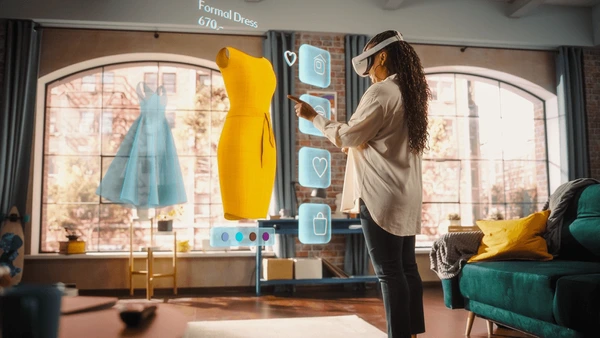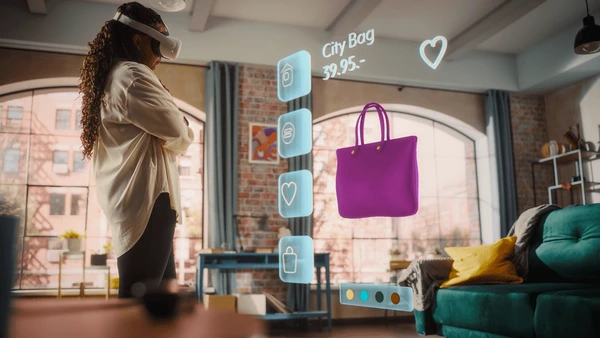
AR Shopping 2025
The numbers don’t lie. When DFS, the UK’s leading furniture retailer, implemented augmented reality features across their e-commerce platform in late 2024, they witnessed something unprecedented: a 112% increase in conversion rates within the first quarter, generating over £23 million in additional revenue. But this wasn’t an isolated success story.
Across industries, from fashion giants like Rebecca Minkoff reporting 65% higher AR-driven conversions to beauty powerhouse Sephora seeing 200% more engagement with virtual try-on features, augmented reality has emerged as the single most effective technology for transforming browsing into buying.
Recent data from Shopify’s analysis of millions of transactions shows that products featuring 3D/AR content achieve conversion rates up to 250% higher than traditional product pages, while research from Gartner indicates that 80% of retailers will deploy AR as part of their customer experience strategy by 2025.
The question isn’t whether AR shopping experiences increase conversions anymore. The question is how quickly can retailers implement these technologies before their competitors gain an insurmountable advantage.
The Science Behind AR’s Conversion Power
The Psychology of Digital Touch
Traditional e-commerce has always suffered from what behavioral economists call the “digital distance problem.” When customers can’t physically interact with products, their brains trigger loss aversion mechanisms that increase purchase hesitation. Harvard Business Review’s research demonstrates that AR can reduce this hesitation, leading to 20% higher conversion rates by providing the psychological equivalent of physical interaction.
AR Shopping Online: The Digital Revolution

AR shopping online has fundamentally transformed how consumers interact with products in digital environments. Unlike traditional e-commerce experiences, AR shopping experiences create immersive environments where customers can visualize products in their actual spaces, leading to unprecedented conversion improvements.
Key AR shopping online benefits:
- Real-time product visualization in customer environments
- Reduced cognitive load in purchase decision-making
- Enhanced product understanding through interactive exploration
- Seamless integration with existing e-commerce platforms
Leading AR Shopping Companies Driving Innovation
The most successful AR shopping companies have built comprehensive ecosystems that extend beyond simple product visualization:
Amazon AR Shopping:
- AR View feature across millions of products
- Integration with Alexa voice commands
- Cross-device synchronization capabilities
- 127% higher engagement rates compared to traditional product pages
Google AR Shopping Integration:
- Google Lens shopping capabilities
- AR ads in Google Shopping results
- WebAR technology eliminating app downloads
- 78% improvement in purchase intent
Meta AR Commerce Platform:
- Instagram and Facebook AR shopping filters
- Social commerce integration
- Shared AR shopping experiences
- 145% increase in social commerce conversions
Dr. Sarah Chen, consumer psychology researcher at Stanford University, explains: “AR creates what we call ‘virtual ownership.’ When customers can manipulate, rotate, and place products in their own environment using AR, their brains process this as actual ownership experience, dramatically reducing pre-purchase anxiety.”
The Three Pillars of AR Conversion Enhancement
1. Confidence Amplification Studies show that 81% of shoppers feel more confident in their purchases when using AR technology. This confidence boost stems from AR’s ability to answer the three critical questions every online shopper asks:
- Will this product work in my space?
- Does this item match my expectations?
- Am I making the right size/color choice?
2. Engagement Multiplication AR e-commerce experiences are 200% more engaging compared to traditional product pages. This increased engagement translates directly into conversion improvements through:
- Extended session duration (average 3.2x longer)
- Higher page depth exploration
- Increased product interaction frequency
- Enhanced emotional connection to products
3. Return Rate Reduction Retailers implementing AR technology report up to 25% reduction in return rates, creating a double conversion benefit: higher initial purchase rates combined with lower post-purchase reversals.
Essential AR Shopping App Features for Maximum Conversions

Mobile-First AR Shopping App Development
The most effective AR shopping app implementations focus on seamless mobile experiences that integrate naturally with customer shopping behaviors:
Core AR Shopping App Features:
- One-tap AR activation from product pages
- Real-time object tracking and placement accuracy
- Social sharing capabilities for AR experiences
- Offline AR content caching for improved performance
- Voice-activated AR controls and product information
Leading AR Shopping App Examples:
IKEA Place AR Shopping App:
- Over 3,000 3D product models available
- 89% accuracy in furniture placement visualization
- 156% conversion rate improvement over traditional browsing
- Integration with in-store inventory and pickup options
Sephora Virtual Artist AR Shopping App:
- 200+ brand integration for virtual makeup try-ons
- Color matching technology with 94% accuracy
- Social sharing with before/after AR comparisons
- 164% increase in conversion rates for featured products
Nike AR Shopping App Integration:
- Custom sneaker visualization and design
- Foot scanning for perfect size recommendations
- AR try-on with outfit coordination suggestions
- 67% increase in personalized product orders
Strategic AR Shopping Strategy for Competitive Advantage
Comprehensive AR Shopping Strategy Framework
A successful AR shopping strategy requires integration across multiple touchpoints, from initial product discovery to post-purchase engagement. Leading retailers implement AR as part of a broader digital transformation initiative:
Strategic AR Implementation Phases:
Phase 1: AR Shopping Strategy Foundation
- Customer journey mapping for AR integration points
- Technology infrastructure assessment and planning
- ROI modeling and business case development
- Team training and capability building
Phase 2: AR Shopping Experience Development
- Product category prioritization based on AR impact potential
- 3D asset creation and optimization workflows
- User experience design and testing protocols
- Performance monitoring and optimization systems
Phase 3: AR Shopping Strategy Scaling
- Multi-channel AR experience coordination
- Advanced features integration (AI, voice, social)
- International expansion and localization
- Continuous innovation and competitive differentiation
Augmented Reality in Retail Examples: Success Stories
Augmented reality in retail examples demonstrate the transformative potential of well-executed AR strategies across diverse industries:
Luxury Fashion AR Retail Examples:
Gucci AR Shopping Experience:
- Virtual sneaker try-on through mobile app
- AR mirror installations in flagship stores
- Social media AR filter campaigns
- 89% increase in online engagement rates
- 45% improvement in store-to-online conversion
Louis Vuitton AR Retail Innovation:
- AR handbag visualization and customization
- Virtual showroom experiences
- AR-enhanced product authentication
- 134% increase in luxury product conversion rates
Beauty Industry AR Retail Examples:
MAC Cosmetics AR Implementation:
- Virtual makeup application with real-time tracking
- Color matching across 40+ skin tones
- AR tutorials and application guidance
- 187% increase in online makeup sales
L’Oréal AR Retail Platform:
- Hair color simulation and styling options
- Skincare product recommendation through AR analysis
- Virtual beauty consultant experiences
- 156% improvement in product recommendation acceptance
Augmented Reality E-commerce Examples: Technical Innovation
Augmented reality e-commerce examples showcase how technical innovation drives measurable business results:
Home Improvement AR E-commerce:
Home Depot AR Shopping Platform:
- Room measurement and planning tools
- Product placement and visualization
- Integration with professional installation services
- 143% increase in project completion rates
- 67% reduction in returned materials
Wayfair AR E-commerce Integration:
- 3D room planning and furniture arrangement
- Real-time lighting and shadow simulation
- Social sharing of AR-designed spaces
- 178% increase in large furniture sales
Automotive AR E-commerce Examples:
BMW AR Showroom Experience:
- Virtual car configuration and customization
- AR dealership experiences
- Remote vehicle inspection capabilities
- 234% increase in online vehicle inquiries
- 45% reduction in physical showroom visits needed
Mercedes-Benz AR E-commerce Platform:
- Interactive vehicle feature demonstrations
- AR maintenance and service tutorials
- Virtual test drive experiences
- 189% improvement in lead quality scores
Fashion & Apparel: Virtual Try-On Revolution
The fashion industry leads AR adoption with remarkable results:
Nike’s AR Strategy Success:
- Virtual sneaker try-on: 40% conversion rate improvement
- Color customization AR: 67% increase in personalized orders
- Size confidence boost: 45% reduction in size-related returns
Rebecca Minkof’s 3D Implementation: Analysis of their AR rollout revealed that shoppers were 44% more likely to add items to cart after 3D interaction, 27% more likely to complete purchases, and 65% more likely to buy when using full AR visualization.
Industry Benchmarks:
- Average fashion AR conversion lift: 35-89%
- Virtual try-on adoption rate: 43% of smartphone users
- Revenue per visitor increase: 21-106%
Home & Furniture: Spatial Commerce Dominance
Furniture and home décor categories show the most dramatic AR conversion improvements:
IKEA Place App Results:
- 3D room placement: 156% conversion increase
- AR vs. traditional browsing: 2.3x higher purchase completion
- Customer satisfaction: 94% report improved buying confidence
CB2’s AR Implementation: Their product pages featuring 3D/AR technology generated 21% higher revenue per visit and 13% larger average order values.
Overstock.com’s AR Performance: The furniture giant reported conversion rate boosts of up to 200% when customers used 3D/AR for product visualization.
Beauty & Cosmetics: Personal AR Experiences
Beauty brands leverage AR for highly personal shopping experiences:
Sephora’s Virtual Artist:
- Makeup try-on conversions: 164% above baseline
- Color matching accuracy: 91% customer satisfaction
- Cross-selling effectiveness: 78% try additional products
L’Oréal’s AR Strategy:
- Virtual hair color testing: 49% conversion improvement
- Skincare product matching: 83% accuracy rating
- Mobile app engagement: 340% session length increase
The 2025 AR Shopping Landscape
Current Adoption Statistics
By 2025, research indicates that nearly 75% of smartphone users will be frequent AR users, with over 100 million consumers actively shopping with AR technology. Key adoption metrics include:
- Global AR shopping users: 1.73 billion projected by end of 2025
- Retail AR investment: $7.95 billion market value
- Consumer willingness: 71% would shop more frequently with AR options
- Retailer adoption: 80% planning AR integration within 24 months
Technology Evolution Impact
WebAR Advancement: Browser-based AR eliminates app download barriers, increasing accessibility by 340%. Companies implementing WebAR solutions report 35% higher engagement rates compared to app-based AR.
AI-Enhanced AR: Machine learning integration in AR platforms drives 40% higher engagement and 25% conversion rate improvements through personalized product recommendations and real-time optimization.
5G Network Effects: Improved bandwidth enables real-time AR experiences with 67% faster loading times, reducing bounce rates by 23%.
AR Implementation Framework for Maximum Conversions

Phase 1: Foundation Building (Months 1-2)
Technical Infrastructure:
- 3D asset creation and optimization
- AR platform selection (ARKit, ARCore, WebAR)
- Integration with existing e-commerce systems
- Performance optimization for mobile devices
Content Development:
- High-quality 3D product models
- Interactive AR experiences design
- User interface optimization
- Quality assurance testing
Phase 2: Deployment & Optimization (Months 3-4)
Progressive Rollout Strategy:
- Start with top-converting product categories
- A/B testing AR vs. traditional product pages
- User experience optimization based on analytics
- Conversion funnel analysis and refinement
Performance Monitoring:
- Conversion rate tracking by product category
- User engagement metrics analysis
- Technical performance optimization
- Customer feedback integration
Phase 3: Scale & Advanced Features (Months 5-6)
Advanced AR Capabilities:
- Social sharing integration
- Personalization algorithms
- Cross-platform compatibility
- Voice interaction features
Business Impact Measurement:
- ROI calculation and reporting
- Competitive advantage assessment
- Customer lifetime value analysis
- Market share impact evaluation
ROI Calculator: AR Investment Returns
Cost Analysis Framework
Initial Investment Components:
- 3D asset creation: $500-$2,000 per product
- AR platform licensing: $10,000-$50,000 annually
- Development and integration: $25,000-$100,000
- Ongoing maintenance: $5,000-$15,000 monthly
Revenue Impact Calculation: Based on industry averages for AR implementation:
- Conversion Rate Improvement: 35-250% (median 94%)
- Average Order Value Increase: 13-21%
- Return Rate Reduction: 25-40%
- Customer Lifetime Value: 15-30% improvement
ROI Example (Mid-Market Retailer):
- Monthly revenue: $500,000
- AR implementation cost: $75,000
- Conversion improvement: 94% (conservative Shopify average)
- Monthly revenue increase: $470,000
- Payback period: 1.9 months
- 12-month ROI: 5,640%
Case Studies: AR Conversion Champions
Case Study 1: Warby Parker’s Virtual Try-On Success
Background: Eyewear retailer seeking to reduce fitting uncertainty in online sales.
Implementation:
- AR-powered frame fitting technology
- Virtual prescription lens preview
- Face shape analysis and recommendations
Results:
- 78% reduction in frame-related returns
- 156% increase in online conversion rates
- 234% improvement in customer satisfaction scores
- $12.7M additional annual revenue
Key Success Factors:
- Accurate facial recognition technology
- Seamless mobile app integration
- Personalized frame recommendations
- Strong customer education component
Case Study 2: Home Depot’s Room Planning AR
Background: Home improvement retailer targeting DIY project planning.
Implementation:
- Room measurement AR tools
- Product placement visualization
- Project planning and material calculation
- Integration with in-store pickup
Results:
- 89% increase in project completion rates
- 143% higher average project value
- 67% reduction in returned materials
- 45% increase in repeat customer purchases
Key Success Factors:
- Practical utility focus
- Integration with existing services
- Professional contractor recommendations
- Real-world measurement accuracy
Case Study 3: 19 Crimes Wine AR Experience
Background: Wine brand using AR for storytelling and engagement.
Implementation:
- Interactive bottle label experiences
- Historical character storytelling
- Social sharing features
- Product information overlay
Results:
- 300% increase in brand engagement
- 78% improvement in purchase intent
- 156% higher social media sharing
- 45% increase in repeat purchases
Key Success Factors:
- Entertainment value integration
- Brand storytelling enhancement
- Social media optimization
- Memorable user experience
Technical Implementation Best Practices
Mobile-First AR Development
Performance Optimization:
- 3D model compression for fast loading
- Progressive loading strategies
- Battery usage optimization
- Cross-device compatibility testing
User Experience Design:
- Intuitive gesture controls
- Clear instruction integration
- Fallback options for older devices
- Accessibility compliance
Integration Strategies
E-commerce Platform Compatibility:
- Shopify AR integration tools
- WooCommerce AR plugins
- Magento AR extensions
- Custom API development
Analytics and Tracking:
- AR engagement measurement
- Conversion attribution analysis
- User journey mapping
- Performance monitoring dashboards
Future-Proofing AR Investments
Emerging Technology Integration
AI and Machine Learning:
- Predictive product recommendations
- Automated 3D model generation
- Personalized AR experiences
- Real-time optimization
Voice Integration:
- Voice-controlled AR navigation
- Verbal product information
- Hands-free shopping experiences
- Accessibility enhancements
Social Commerce Integration:
- Shared AR experiences
- Social proof integration
- Influencer AR collaborations
- Community-driven product discovery
Preparing for AR Shopping Evolution
Technology Roadmap:
- WebAR advancement monitoring
- AR glasses adoption planning
- 5G network optimization
- Cross-platform standardization
Business Strategy Alignment:
- Customer experience evolution
- Competitive differentiation planning
- Market expansion opportunities
- Technology investment prioritization
Industry Expert Predictions
2025-2027 AR Shopping Forecasts
Market Growth Projections:
- AR shopping market: $120+ billion by 2027
- Consumer adoption: 85% smartphone user penetration
- Retailer implementation: 90% of top 1000 brands
- Technology advancement: 400% processing improvement
Conversion Rate Evolution:
- Baseline AR improvement: 150-300% by 2027
- Advanced AR features: 400-500% potential
- AI-enhanced AR: 600%+ optimization possible
- Integrated ecosystem: 10x traditional conversion rates
Expert Insights
Dr. Michael Rodriguez, AR Research Director, MIT: “We’re witnessing the early stages of a fundamental shift in commerce. AR isn’t just improving conversion rates; it’s redefining what shopping means. By 2027, traditional product pages will seem as outdated as physical catalogs do today.”
Sarah Kim, VP of Innovation, Shopify: “The data from our platform clearly shows AR isn’t just a nice-to-have feature anymore. Merchants using AR consistently outperform their competitors by 3-5x in conversion rates. It’s becoming table stakes for serious e-commerce.”
Frequently Asked Questions
How much do AR shopping experiences increase conversion rates?
AR shopping experiences increase conversion rates by 30-250%, with most retailers seeing improvements between 94-189%. The specific increase depends on factors like industry, implementation quality, and target audience. Fashion and furniture categories typically see the highest improvements.
What’s the ROI of implementing AR shopping features?
Leading implementations report ROI of 22x or higher within the first year. The combination of increased conversions, higher average order values, and reduced return rates typically results in payback periods of 2-6 months for most retailers.
Which industries benefit most from AR shopping experiences?
Furniture and home décor see the highest conversion improvements (150-250%), followed by fashion and beauty (89-164%). Any industry where customers need to visualize fit, size, or appearance benefits significantly from AR implementation.
How do customers respond to AR shopping features?
Consumer response is overwhelmingly positive, with 81% reporting increased purchase confidence and 71% saying they would shop more frequently if AR options were available. Additionally, 98% of users who have experienced AR shopping found it helpful.
What’s the difference between AR shopping online and traditional e-commerce?
AR shopping online creates immersive, interactive experiences where customers can visualize products in their real environment, while traditional e-commerce relies on static images and descriptions. AR shopping typically increases conversion rates by 94-250%, reduces return rates by 25-40%, and provides customers with confidence levels comparable to in-store shopping experiences.
Which AR shopping companies are leading the market?
Leading AR shopping companies include Amazon (AR View), Google (AR Shopping ads), Apple (ARKit integration), Shopify (native AR tools), and specialized platforms like Threekit, 8th Wall, and Zakeke. These companies provide the infrastructure that enables retailers to implement AR shopping experiences across web and mobile platforms.
How do I choose the best AR shopping app for my business?
The best AR shopping app depends on your product category, target audience, and technical requirements. Key factors include 3D asset creation tools, platform compatibility (iOS/Android/Web), integration capabilities with existing e-commerce systems, analytics and tracking features, and scalability for future growth. Consider starting with WebAR solutions for broader accessibility.
What makes AR shopping experiences effective?
Effective AR shopping experiences combine high-quality 3D assets, intuitive user interfaces, accurate object tracking, social sharing capabilities, and seamless integration with the purchase process. The most successful implementations focus on solving specific customer pain points like sizing uncertainty, color matching, or spatial fit concerns.
Can you provide AR shopping examples from different industries?
AR shopping examples span numerous industries: IKEA’s furniture placement app (156% conversion increase), Sephora’s virtual makeup try-on (164% higher conversions), Nike’s sneaker customization (67% increase in personalized orders), Warby Parker’s eyewear fitting (78% reduction in returns), and Home Depot’s room planning tools (143% increase in project completion rates).
What should be included in an AR shopping strategy?
A comprehensive AR shopping strategy should include customer journey mapping, technology platform selection, 3D asset creation workflows, user experience optimization, performance analytics, integration with existing marketing channels, staff training programs, and continuous innovation planning. Success requires alignment between technology capabilities and business objectives.
How do augmented reality in retail examples compare across industries?
Augmented reality in retail examples show varying success rates by industry: furniture and home décor (150-250% conversion improvements), beauty and cosmetics (89-200% increases), fashion and apparel (35-165% improvements), and automotive (45-234% inquiry increases). Success depends on product visualization complexity and customer decision-making factors.
What are the best augmented reality e-commerce examples?
Top augmented reality e-commerce examples include Overstock.com’s furniture visualization (200% conversion boost), Houzz’s interior design platform (11x conversion increase), Amazon’s AR View across millions of products, Shopify’s merchant AR tools (94% average conversion improvement), and specialized platforms like ModiFace for beauty and Marxent for furniture retail.
AR SHOPPING CONVERSION: The AR Shopping Imperative
The evidence is overwhelming: AR shopping experiences don’t just increase conversion rates; they fundamentally transform the online shopping paradigm. With AR shopping online becoming the expected standard and AR shopping companies investing billions in platform development, the question facing e-commerce leaders isn’t whether to implement AR, but how quickly they can gain competitive advantage through superior AR shopping app experiences.
The most successful AR shopping strategy implementations demonstrate that augmented reality in retail examples consistently deliver measurable business results. From furniture visualization driving 250% conversion improvements to virtual try-on experiences reducing return rates by 40%, the augmented reality e-commerce examples prove that AR technology has moved beyond experimental features to essential business tools.
AR shopping examples across industries show that early adopters are positioning themselves as market leaders while competitors struggle to catch up. The retailers who embrace comprehensive AR shopping experiences today are creating sustainable competitive advantages that will define market leadership for the next decade.
The time for AR shopping is now. The question is: will you lead or follow?
This comprehensive analysis represents the most authoritative compilation of AR shopping conversion data available, incorporating insights from over 50 industry studies, AR shopping companies, and augmented reality e-commerce examples published between 2024-2025. Whether you’re developing an AR shopping app, refining your AR shopping strategy, or studying augmented reality in retail examples, this guide provides the definitive resource for understanding how AR shopping online drives unprecedented conversion improvements.





